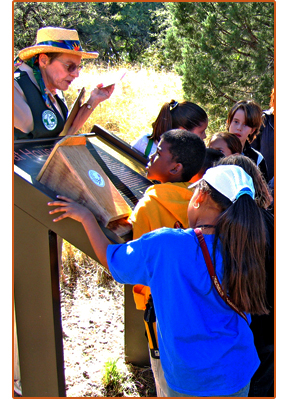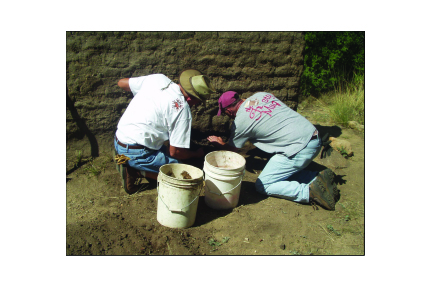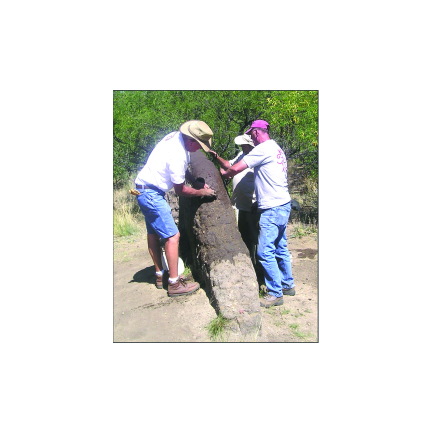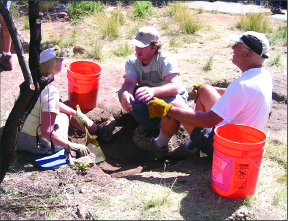White House - Passport in Time
Main menu:
PIT Highlights > Headlines > 2004
Working on the White House
Coronado National Forest, Arizona, 2002-2004
from Friends of Madera Canyon, Education/Conservation Section
http://www.friendsofmaderacanyon.org/passport_in_time_PIT_project.html (Original Article)
The Friends of Madera Canyon has been active in the exploration and preservation of the White House ruin, the most significant recent-history archeological site in Madera Canyon. The ruin site is located on a short, paved spur trail off the Proctor Accessible Nature Loop Trail just above the Proctor Road crossing.
Two Passport in Time (PIT) work projects were conducted at the ruin with Friends volunteers and U.S. Forest Service (USFS) archaeologists in 2002 and 2004 (an abridged version of the 2004 report follows). These “digs” provided adobe stabilization to the one remaining standing wall of the house, explored several of the circular depressions in the immediate vicinity of the ruin for artifacts, and completed a number of test excavations in the structure’s interior fill for artifacts. A variety of utensils, tools, pottery pieces, glass, and other artifacts were unearthed and the original rock foundation of the White House was uncovered.
Friends volunteers and USFS archeologist Chris Schrager mixed adobe on site and performed additional adobe stabilization to preserve the remaining wall in the summers of 2007 and 2009. Volunteers applied adobe mud to form a sacrificial cap on the top of the wall and a rain splash-guard along the base to help preserve the original adobe bricks from eroding away in the weather. Regular, additional adobe work will be needed to maintain the cap and splash-guard.
 The White House is believed to have been built by a sheepman named Walden in the late 1870s or early 1880s. It was used as a family vacation home in the 1880s by Tucson merchant Theodore Wellish, who may have been the individual that originally whitewashed the two-room adobe cabin. The canyon became known as “White House Canyon” as a result. The White House was a highly visible landmark from the surrounding area and was an important survey marker in the staking of local mining claims. After being occupied by the Paz brothers early in the 1900s, the Alcario Morales family lived in the White House from 1911 until 1941. A photo of the White House, ca. 1930, can be seen on the cover of the 2009 Friends publication, A History of Madera Canyon, in which a more detailed account of the historic structure is written.
The White House is believed to have been built by a sheepman named Walden in the late 1870s or early 1880s. It was used as a family vacation home in the 1880s by Tucson merchant Theodore Wellish, who may have been the individual that originally whitewashed the two-room adobe cabin. The canyon became known as “White House Canyon” as a result. The White House was a highly visible landmark from the surrounding area and was an important survey marker in the staking of local mining claims. After being occupied by the Paz brothers early in the 1900s, the Alcario Morales family lived in the White House from 1911 until 1941. A photo of the White House, ca. 1930, can be seen on the cover of the 2009 Friends publication, A History of Madera Canyon, in which a more detailed account of the historic structure is written.The Education Program 4th Grade Nature Walks visit the White House ruin as part of their activities. At the “White House Station,” a docent gives students a brief talk on the White House, adobe construction, and significant Madera Canyon history. Students get a chance to see some artifacts found in the canyon and also compare the ruin with a photo of the original adobe abode.
Results of the “Working in the Whitehouse II” PIT Project
May 4 – 6, 2004 at Whitehouse Ruin, Site AR03-05-02-31
Nogales Ranger District, Coronado National Forest
Heritage Resources Report #2004-05-55 (abridged)
June 10, 2004
Introduction
May 4 – 6, 2004 at Whitehouse Ruin, Site AR03-05-02-31
Nogales Ranger District, Coronado National Forest
Heritage Resources Report #2004-05-55 (abridged)
June 10, 2004
Introduction
The Whitehouse Ruin (Site #AR03-05-02-31), an historic property built over a century ago, was the site of a three-day workshop designed to provide Forest Service archaeologists and volunteers with an opportunity to learn and practice preservation and excavation techniques while continuing research and stabilization efforts on the historic adobe structure. This project follows an earlier PIT project (“Working in the Whitehouse”, Nov.13 – 15, 2002) described in Heritage Resource Report #2003-05-17. That project accomplished several goals:
It provided hands-on training in adobe preservation to volunteers, who subsequently assumed primary responsibility for monitoring and maintaining the site; We exposed a sufficient portion of the structure’s foundation to determine its original size and orientation; We completed documentation and mapping of several previously unrecorded features associated with the ruin.
Although the site was determined not eligible for listing on the National Register of Historic Places in 1987 (HRR #1987-05-073), the ruin has been signed as an interpretive feature as part of an accessible trail in the Madera Canyon Recreation Area. Several goals were outlined for this project: To provide hands-on training in adobe preservation to new volunteers, who will help monitor and maintain Whitehouse Ruin and other historic adobe structures on the Nogales ranger District; To undertake test excavations within the structure’s interior, and at several nearby pits located during the previous project; To investigate further the temporal and spatial associations of artifacts and features at the site, to ascertain whether the Determination of Non-eligibility for listing on the National Register of Historic Places should be re-evaluated; and To increase public awareness of, and membership in, the Forest Service’s Passport In Time program as well as strengthen the Coronado’s partnerships with local volunteer organizations.
Background
In 1987, Coronado National Forest Heritage staff inspected the remains of the Whitehouse to determine stabilization needs and eligibility for listing on the National Register of Historic Places (HRR #1987-05-073). In consultation with the State Historic Preservation Officer, the ruin was determined to lack the integrity of design, materials, workmanship, or feeling necessary for a National Register site; further, at that time, the site was considered to have little potential to provide important information because of the paucity of associated artifacts and features. Stabilization efforts were undertaken later that year (HRR #1987-05-004). A cooperative effort by the Coronado National Forest and the Friends of Madera Canyon resulted in a path to the site and bilingual interpretive sign being installed in 1989. Maintenance work has been performed intermittently since that time, and further deterioration has been avoided.
The 2002 PIT project continued stabilization efforts, exposed portions of the structure’s foundation, and mapped 21 other features in the vicinity. The recommendations in the subsequent report included further excavation and documentation, reconsideration of the site’s eligibility for listing on the National Register of Historic Places, and continuation of cooperative stabilization efforts with the Friends of Madera Canyon.
The Project
Eight volunteers and six Coronado National Forest archaeologists participated in the workshop from May 4 – 6, 2004. Participants’ involvement ranged from a portion of one day to the full three days. Brief training demonstrations on safety, documentation, and preservation techniques were given at the beginning of each morning and afternoon work session, and participants were encouraged to spend time at a variety of tasks, developing a range of skills. Substantial progress was made toward each of the project’s objectives.
Adobe stabilization – The remaining portion of the adobe wall was inspected, and photographs of the previous project’s efforts used to determine deterioration. Although evidence of recent rodent damage was found, repairs from 18 months earlier appeared to have arrested erosion along the top of the wall and at its base. The rodent tunnels were plugged with small rocks and adobe on both the interior and exterior. A sacrificial layer was amended to areas where basal coving had previously occurred.

(Photo: A sacrificial cap coat was applied to the top of the wall segment to protect the remaining original fabric from further weathering.)

(Photo: Although slump from the base of the wall’s eroded exterior was used for the repairs, volunteers were shown how to locate sand and clay soil from local sources, and determine the best mixture for a particular application. Several of the volunteers expressed interest in accompanying Forest service archaeologists on future adobe repair projects planned for other sites on the Nogales Ranger District.)
Test excavations of interior fill -- Anecdotal records have referred to the Whitehouse as a “two-room structure”, but no conclusive evidence of interior walls was discovered during the exposure of the north and east wall foundations during the previous project. The location of the first two test units was determined by three factors: the likelihood of finding evidence of any interior walls; the best chance of uncovering artifacts and other features; and the most efficient logistical arrangement for the training of our volunteers in layout, excavation, and mapping. Because the foundation exposure work during the previous PIT project was recorded as four units, the first two test excavations were designated Test Units 5 and 6. Each was a one-meter square, laid out parallel to the walls. Test Unit 5 was located in the northwest corner of the structure’s interior; T.U. 6 at the intersection of the structure’s midlines. A common datum was established for all test units.
Volunteers assisted Forest Service archaeologists in the layout of the units, and recorded surface conditions. Excavation was done by hand, with fill dry-screened through a ¼” mesh. Artifacts were bagged by level and material type. Both test units were excavated to floor depth, as indicated by hard-packed clay surface and/or fieldstone paving within the structure’s perimeter foundation.

(Photo: Discussion of Eligibility)
The Whitehouse Ruin site is the oldest remaining historic structure in Madera Canyon, a high-profile recreational area within an hour’s drive of nearly a million residents and many more annual visitors. Originally constructed as a ranching shelter, it became the first permanent “summer home” in an area whose historic development has been defined by public recreational use. The site’s evolution from practical to recreational functions mirrors the change in land usage and Forest Service management of Madera Canyon. Therefore it is considered eligible under Criterion A for its “association with events that have made a significant contribution to the broad patterns of our history”.
The house was built with adobe and lime plaster, using local materials. The construction design and methods were typical of those historically used in the border region of northern Sonora and southern Arizona and New Mexico. These methods and materials are no longer used extensively, and increasingly, the remaining examples of adobe and lime plaster construction are falling victim to deterioration, or being replaced by structures constructed using modern materials and techniques. Those that do survive are often stabilized or rehabilitated with modern, cement-based materials. As a result, the Whitehouse ruin “embodies the distinctive characteristics of a type, period, or method of construction”, and is therefore also considered eligible under Criterion C.
Finally, exposure of the structure’s foundation and test excavations of the interior fill yielded a variety of historic material. Further excavation of the interior has the potential to yield information important to our understanding of daily life during the succession of occupations. Therefore, the property is considered eligible under Criterion D.